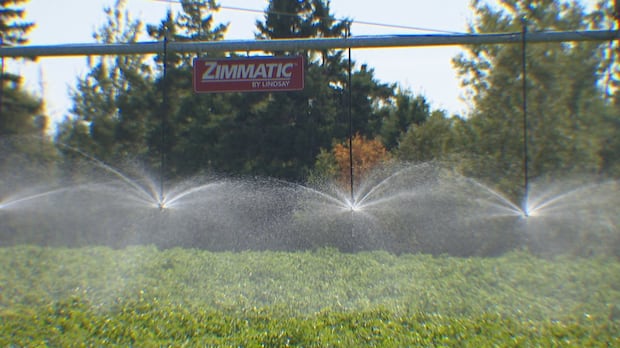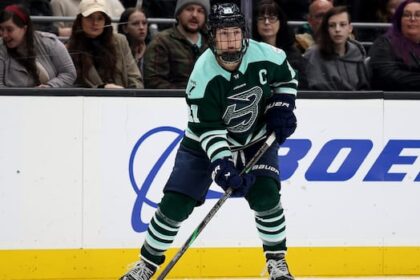PEIThe dry conditions P.E.I. experienced this summer have led to a surge in irrigation requests from farmers, prompting the province to carefully balance crop needs with long-term water sustainability. ‘The weather’s been changing the last number of years… this isn’t getting to be a fluke’Thinh Nguyen · CBC News · Posted: Nov 11, 2025 5:00 AM EST | Last Updated: 3 hours agoListen to this articleEstimated 6 minutesThe audio version of this article is generated by text-to-speech, a technology based on artificial intelligence.Terry Curley of Monaghan Farms currently has several applications before the province for irrigation wells. (Alex MacIsaac/CBC)Terry Curley of Monaghan Farms in Norboro, P.E.I., never used to think much about installing irrigation systems on his fields.Now, he has several applications before the province for irrigation wells, part of a multi-million-dollar plan to have most of his crops irrigated within two or three years.The reason, he said, is the increasingly dry conditions P.E.I. has experienced in recent years. Curley said this past summer’s lack of rainfall is among the worst he has seen in decades, comparable only to what he saw in 2001.“Most growers can accept or handle maybe one in 10 or 15 years, but the weather’s been changing the last number of years, as everyone knows. So this isn’t getting to be a fluke,” Curley told CBC News.LISTEN | Dry P.E.I. summer leads to flood of irrigation requests:This is PEI17:59Dry P.E.I. summer leads to flood of irrigation requestsMany P.E.I. farmers are looking to irrigate more land after spending much of the summer under drought conditions. Mitch explores how the application process works and what rules protect your drinking water.The potatoes grown at Monaghan Farms are processed into potato chips for Frito-Lay, so quality standards are critical. Curley said he’s willing to invest millions to improve the quality of his crops.“Nobody wants to spend that kind of money, but you could see the trend… it’s getting warmer, it’s getting drier, the weather is more extreme,” he said.Curley’s applications are among about 70 submitted to the P.E.I. government in recent months, as farmers have increasingly sought approval to irrigate their fields.The government must decide how many to approve while balancing the need for farm irrigation with sufficient drinking water for Islanders. That’s a process that requires careful monitoring of the province’s water levels.“It’s been busy all summer, actually, with the drought conditions we’ve had,” said Sean Ledgerwood, P.E.I.’s manager of water and air monitoring.“We’ve had to watch our water levels, especially in the surface water side, to make sure that they’re at the proper levels and still enough water there for people to use.”How the process worksLedgerwood said the province has rules in place for farmers who want high-capacity wells, designed to protect P.E.I.’s water resources.Farmers must complete a two-step process. The first step is obtaining a groundwater exploration permit, which costs $50.This allows a test well to be drilled to determine if the desired volume and quality of water is available and environmentally acceptable. Provincial hydrogeologists assess the proposed location based on a number of criteria.“Some of the things we look at is: where exactly you want to put the well? Is it close to a stream? Is it close to residences? And we look at that and just kind of say, ‘Well, maybe you want to move it a little bit farther away from a house, so it doesn’t impact that well, or move it away from the streams.’”Sean Ledgerwood, P.E.I.’s manager of water and air monitoring, said with this past summer’s dry conditions, the department has been keeping a close eye on monitoring the Island’s water levels. (CBC)Hydrogeologists also evaluate water availability and sustainability based on the watershed, and determine whether a new high-capacity well can operate without harming the environment or existing users. Ledgerwood said some high-farming areas, such as those around the Dunk River and Wilmot River, already have many wells.The second step in the process requires applying for a water withdrawal permit, which is necessary for large water users needing more than 25 cubic metres a day.Applicants must submit a drought contingency plan, so that during periods of extreme dryness, water use can be restricted. They must also submit a soil health improvement plan.Irrigation boosts potato qualityCurley, who is both a potato grower and dealer, works with 11 growers and noted that for those with irrigated fields, testing shows the potatoes have about half the sugar content of non-irrigated potatoes.He said this is important because high sugar levels can cause potatoes to burn when they are made into chips.“The irrigated is better quality,” Curley said.Irrigated potatoes are better quality, with about half the sugar content of non-irrigated potatoes, Terry Curley says. (CBC)At Cavendish Farms, the company is also encouraging growers to invest in irrigation and has provided grants to help.Jubs Bristow, the company’s vice-president of agriculture, said Cavendish Farms has a grant program in place for growers developing irrigation systems, and the company also plans to work with the P.E.I. Potato Board and provincial government on additional programs to support supplemental irrigation.“We continue to encourage growers to make use of it and irrigate where they can irrigate, because if these weather trends continue, it’s just not going to be an option not to have some irrigation on your properties,” Bristow said.He added that the company would like to see between 30 and 50 per cent of P.E.I.’s potato acreage under irrigation.Province’s ongoing monitoringLedgerwood said the province’s oversight doesn’t stop once irrigation wells are approved.Farmers must record how much water they pump and submit usage data to the government. Each permit sets a specific extraction limit, averaged over the month.“At the end of the day, they can’t go over the amount that they have in their permit,” Ledgerwood said.The province also monitors surface water in areas like streams and rivers where water is withdrawn for irrigation.The Dunk River area is among those high-farming areas that already have many high-capacity wells. (Jane Robertson/CBC)On P.E.I., a water withdrawal permit is required to take more than 25 cubic metres of surface water per day from those areas.Ledgerwood said surface water withdrawals can have a more visible impact than groundwater wells.“The amount that you can withdraw is probably the same, but as you get into drought conditions like… this year, that’s probably the first one we’re going to look at and say, ‘Hey, this is too low, and you have to either turn it off or or reduce the amount that you’re taking,’” he said.The P.E.I. Water Registry website provides real-time stream levels. If a stream or river falls below its maintenance flow — the minimum needed to keep a healthy ecosystem for fish and other aquatic life — any water withdrawals must stop immediately. With files from This is P.E.I.
As summers get drier, irrigation becomes a top priority for P.E.I. farmers












